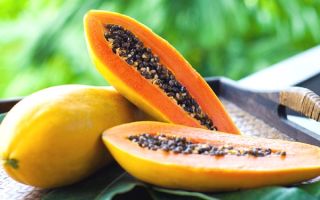Content
- 1 What does papaya look like and where does it grow?
- 2 The chemical composition and calorie content of papaya
- 3 How papaya is useful for the body
- 4 Benefits of papaya for pregnant women
- 5 Can papaya be breastfed?
- 6 At what age can papaya be given to children
- 7 Is papaya good for weight loss?
- 8 Papaya seeds: benefits and uses
- 9 The use of papaya for medicinal purposes
- 10 How papaya is used in cosmetology
- 11 What can be made from papaya
- 12 How to peel and eat papaya
- 13 The benefits and harms of dried papaya
- 14 Papaya harm and contraindications
- 15 How to choose and store papaya
- 16 Conclusion
Many healthy exotic fruits can be found in grocery stores across the country. Many of them, unfortunately, are not very popular, such as papaya. This is due to the fact that people are new to her. In addition, few people know what the benefits and harms of papaya are.
So what is papaya, how is it useful and what contraindications does it have? More on this later in the article.
What does papaya look like and where does it grow?
There are two types of papaya:
- Hawaiian. The shape resembles a pear. The maximum weight is 500 g. When ripe, the peel is yellow, the flesh is pink or bright orange. The pulp tastes like a melon. In the center are black seeds.
- Mexican. The maximum weight reaches 5 kg, so the size of the Mexican species is larger than the Hawaiian one. When ripe, the color of the flesh can be pink, yellow or orange.
There are also wild, Filipino, mountain and Dutch varieties, Torpedo and Red Lady varieties.
In nature, the fruit grows in Asia and in the tropical regions of America. In many countries, including Russia, papaya trees are planted for useful experimental purposes.
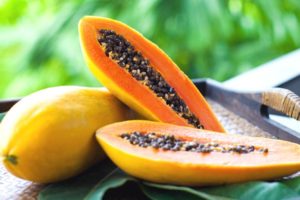
The chemical composition and calorie content of papaya
100 g of pulp contains:
- 0.5 g of proteins (0.61% of the norm);
- 0.3 g fat (0.46% of the norm);
- 10.8 g carbohydrates (8.44% of the norm);
- 1.7 g dietary fiber (8.5% of the norm);
- 88.06 g of water (3.44% of the norm).
The calorie content of papaya per 100 grams is 43 kcal.
As can be seen from the composition, the content of useful carbohydrates is overwhelming: 0.6 g of fat and 21.6 g of carbohydrates per 1 g of protein. This information will help you know if a product is in compliance with a person's nutritional requirements or dietary requirements.
- There is a large amount of useful vitamin C. Its share in relation to other vitamins in 100 g of the product can reach 68 g.
- This is followed by vitamin B4, of which 100 g contains 6.1 mg.
- In addition, there are vitamins A, B1, B2, B5, B6, B9, E, K, PP, as well as lycopene and lutein.
As for useful macro- and microelements, papaya contains the most potassium (182 mg per 100 g), magnesium (21 mg), calcium (20 mg), phosphorus (10 mg) and sodium (8 mg). Besides them, there is copper, manganese, selenium, iron and zinc.
How papaya is useful for the body
It is important that papaya fruits provide both benefits and harm. They contain substances that improve digestion: they promote the breakdown of proteins and their conversion into fats. But if the body accumulates too much protein, then diabetes can occur.
For those with arthritis, you can also add papaya to your menu, which, thanks to the enzyme chymopapain, helps relieve pain and eliminates the manifestations of osteoarthritis.
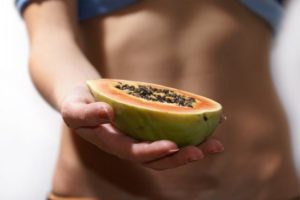
Benefits of papaya for pregnant women
Use during pregnancy:
- Prevents anemia from developing due to folic acid.
- Normalizes the blood circulation process.
- Helps detoxify the body.
- Recommended for those who have stretch marks on their skin.
Pregnant women should not get carried away with papaya either. An unripe fruit with green skin contains peptin, which causes frequent contractions of the uterus and, as a result, premature birth.
Also, healthy juice tends to normalize the menstrual cycle.
Can papaya be breastfed?
Nursing mothers are generally advised to exclude the following fruits from the menu:
- red and orange (the pigment that gives this color causes rashes and spots on the body);
- citrus (vitamin C is also a strong allergen).
Therefore, it is better for them to exclude papaya from the menu.
It has been proven that the stomach tends to better assimilate those foods that grow in the place of residence of a person. Papaya, as mentioned above, practically does not grow in Russia and the CIS.

If you do not want to give up healthy and harmful exotic foods, then it is better to eat them in small quantities and not in the first weeks after the birth of the child. So it will turn out to "acquaint" the baby with new useful nutrients and instill in him antibodies of harmful allergens for the future.
At what age can papaya be given to children
Papaya can be both beneficial and harmful to a child's health.
The age at which it can be introduced into the diet is not fixed anywhere. Do not give papaya from the first or second feeding. Some parents risk adding it to their food at 6-8 months (only on condition that the baby assimilates the usual foods normally). And yet, tropical foods will be healthier no earlier than 8-10 months or even after a year.
If the child safely digests a familiar food like potatoes or pumpkin and they decide to give him papaya, then this should be done as follows:
- Process the pulp into a puree consistency.
- Give a teaspoon a day no more than 4 times a week.
- Closely monitor the baby's reaction.
If there is harm from allergies, then its property will manifest itself rather quickly.
Is papaya good for weight loss?
The benefits of papaya for the human body are significant.
The low energy value of a useful product allows those who follow their figure to take it (you need to comply with the norm, otherwise the body will be harmed) in order to get the necessary vitamins and not overeat.
The fruit is sweet, but contains little sugar, which can also be attributed to beneficial properties, especially for those who play sports or have diabetes.
It was said above that nutrients regulate stress hormone levels. This is also a good slimming property. The harm of stress in this problem is obvious.

With a nervous breakdown, a person loses a lot of useful energy. To replenish it, you have to eat something. Most often, people in this state do not control what food they eat: they eat everything and gain significant weight, causing harm to the body. With constant stress, overeating is generally a habit. The harm is increasing.
Papaya can be a great medicine: it can help you stay full (without overeating) and normalize stress hormone levels. As a result, there are no nerves and obesity.
Papaya seeds: benefits and uses
When cleaning, many throw away the seeds. In fact, it is unwise to neglect the use of papaya seeds for medicinal and preventive purposes.It is difficult to overestimate the benefits of their properties:
- The chemical composition of seeds contains phenolic compounds and flavonoids, which prevent the development of tumors due to their preventive properties.
- because of proteolytic enzymes seeds help get rid of parasites.
- Papain not only breaks down proteins in the stomach, but also destroys helminth deposits.
- Karpain helps in the fight against parasitic worms and amoeba.
This is how papaya enzymes benefit.
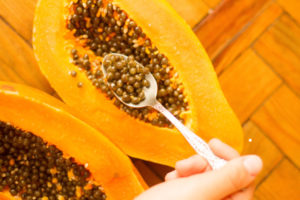
If you grind five seeds, mix with a tablespoon of lime juice (fresh) and take a couple of times a day for a month, you can see significant improvements in liver cirrhosis.
The only thing that must be done beforehand is to consult a doctor about the use of this mixture.
True, it is better for pregnant and lactating women to refrain from eating papaya seeds.
The use of papaya for medicinal purposes
The valuable properties of a decoction from the leaves can be used as a cure for respiratory diseases, and if you mix milk or mint tea with the juice of the leaves or green fruits, you get a good tincture to fight intestinal parasites. Papaya flower tincture helps induce menstruation.
In addition, the product has the ability to quickly heal wounds, strengthens the immune system and the cardiovascular system.
Papaya is also good for the intestines. Daddy's seeds help fight off pathogenic bacteria, thereby improving the properties of microflora.
For wound healing
Seed powder helps in wound healing. It contains substances that kill harmful microbes and bacteria, and the juice of the green fruit prevents the formation of edema at the wound site and the occurrence of pus. The crude product contains a protease enzyme, which also accelerates wound healing.
To improve vision
Due to the content of useful substances, the pulp is recommended to be eaten with vision problems. Regular consumption of the pulp helps to avoid dystrophy of the retina of the eyeball, which entails loss of vision with age. Beta-carotene improves eye muscle function.
For the prevention of atherosclerosis
Papaya vitamins A, C and E prevent atherosclerosis, promote healthy heart function. Vitamin C also regulates stress hormones.
With intervertebral hernia
A hernia occurs for many reasons:
- from a sedentary lifestyle;
- due to improper posture;
- as a result of incorrect load distribution;
- due to osteochondrosis.
It helps to cure extract from papaya, which, due to its properties, is able to restore connective tissue in the discs between the vertebrae.
How papaya is used in cosmetology
The fruit is widely used in cosmetology due to the fact that vitamins A and C are included in skin and hair care products. Various papaya-based preparations are used to restore skin. The juice is able to remove dead skin cells, restoring its healthy structure. In addition, the product is found in scrubs, creams, soaps, toothpaste and shaving foam.

Papaya face masks
Masks have the ability to cleanse the skin and make it glow, and also remove toxins and provide a rejuvenating effect, treat acne.
To use the product for cosmetic purposes to renew the skin on the face, you can use the following cream recipe:
- Grind 5 g of pulp.
- Mix it with 20 g of shea butter and 20 g of sour cream.
- Place the mixture in a cosmetic jar.
- Store in the refrigerator for no more than a week.
The cream should be used instead of the night fluid.
The mask is not recommended for use in the presence of wounds.
Papaya oil for hair
The oil, which is applied to the hair, gives it shine and silkiness, fights dandruff and helps to strengthen the hair follicles, and also generally improves the condition of the skin on the head.
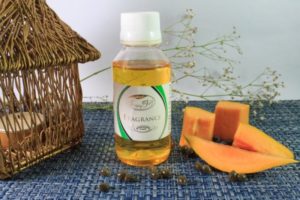
The oil is made from the seeds of the fruit and is combined with various acids such as palmitic or oleic, which makes its properties universal.The mixture can be used as:
- air conditioner;
- anti-inflammatory agent;
- soft peeling;
- balm or mask.
The oil should not be used by people with harmful allergic reactions to the substances contained in it.
What can be made from papaya
In modern cooking, exotic fruit is in demand. Its scope is extensive:
- salads;
- Dessert;
- smoothies;
- cocktails;
- meat and fish dishes;
- pancakes;
- cakes and pastries;
- ice cream.
Some people grind the seeds and use them as spices.
How to peel and eat papaya
There are several ways to peel and eat the fruit:
- Cut in half, remove the seeds and eat with a spoon like a watermelon.
- Cut into slices.
- Peel off the skin with your fingers and eat the pulp with a spoon.
- Peel the skin with your hands and eat without cutlery, like a pear or a peach.
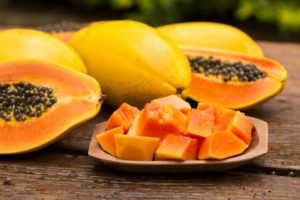
The benefits and harms of dried papaya
The benefits of dried papaya for the body, as well as the benefits of dried papaya, can hardly be overestimated.
A serving of unsweetened dried fruit contains 14 g of carbohydrates (the norm for a healthy adult is 225 g). Carbohydrates are fuel for humans. The same serving contains about 3 g of dietary fiber (30 g is the norm), which improves bowel function and lowers cholesterol and sugar.
Dried fruit is good for a balanced diet. The benefit of dried papaya fruit is that it is an excellent source of healthy fiber.
Although there is much less vitamin C in them compared to fresh fruits, the benefits of candied papaya are undeniable.
Papaya harm and contraindications
Papaya is a fruit that is both beneficial and harmful.
An unripe fetus contains harmful latex milk juice with toxic properties, it can also cause premature uterine contraction in pregnant women, resulting in miscarriage.
Eating dried papaya in food can cause irreparable harm to people with diabetes. You should always control the amount of dried fruit you eat because it contains additional sweeteners that can be harmful to dental health and weight.
How to choose and store papaya
When choosing, consider the following:
- The fruit must not be damaged.
- The color of a ripe fruit should not be green (harmful to health), but a rich orange or yellow.
- Ripe overripe fruit has a sweet smell.
- The fruit should be soft but firm.
- The smaller the fruit, the tastier.
It can be stored for a year, but papaya acquires a special taste in spring or autumn. The fruit retains its taste and medicinal qualities if stored at a temperature of about 10 degrees Celsius.
To speed up ripening at home, you can put the papaya in the same bag with the banana.

Conclusion
Papaya is a healthy fruit that has a maximum of useful and even medicinal properties and a minimum of contraindications. Yes, the benefits and harms of papaya are undeniable. The pulp helps to develop and maintain the body in a normal state.
The only thing to do before adding pulp or seeds to your diet is to consult a specialist. Some people may have a harmful allergic reaction to papaya substances. For some, use can be harmful for other reasons.

